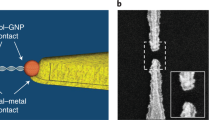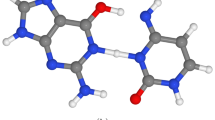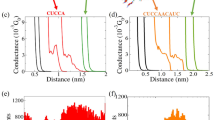Abstract
Charge transport in molecular systems, including DNA, is involved in many basic chemical and biological processes, and its understanding is critical if they are to be used in electronic devices. This important phenomenon is often described as either coherent tunnelling over a short distance or incoherent hopping over a long distance. Here, we show evidence of an intermediate regime where coherent and incoherent processes coexist in double-stranded DNA. We measure charge transport in single DNA molecules bridged to two electrodes as a function of DNA sequence and length. In general, the resistance of DNA increases linearly with length, as expected for incoherent hopping. However, for DNA sequences with stacked guanine–cytosine (GC) base pairs, a periodic oscillation is superimposed on the linear length dependence, indicating partial coherent transport. This result is supported by the finding of strong delocalization of the highest occupied molecular orbitals of GC by theoretical simulation and by modelling based on the Büttiker theory of partial coherent charge transport.
This is a preview of subscription content, access via your institution
Access options
Subscribe to this journal
Receive 12 print issues and online access
$259.00 per year
only $21.58 per issue
Buy this article
- Purchase on Springer Link
- Instant access to full article PDF
Prices may be subject to local taxes which are calculated during checkout




Similar content being viewed by others
Change history
17 January 2017
In the version of this Article originally published, in ref. 19, in the author list, the second, third and fourth authors were not included and the reference should have read: 'Grib, N. V., Ryndyk, D. A., Gutiérrez, R. & Cuniberti, G. Distance-dependent coherent charge transport in DNA: crossover from tunneling to free propagation. J. Biophys. Chem. 1, 77–85 (2010).' This has now been corrected in the online versions of this Article.
References
Wallace, S. S. Biological consequences of free radical-damaged DNA bases. Free Radic. Bio. Med. 33, 1–14 (2002).
Kawanishi, S., Hiraku, Y. & Oikawa, S. Mechanism of guanine-specific DNA damage by oxidative stress and its role in carcinogenesis and aging. Mutat. Res. Rev. Mutat. 488, 65–76 (2001).
Murphy, C. J. et al. Long-range photoinduced electron-transfer through a DNA helix. Science 262, 1025–1029 (1993).
Giese, B. Long-distance charge transport in DNA: the hopping mechanism. Acc. Chem. Res. 33, 631–636 (2000).
Seeman, N. C. Nanomaterials based on DNA. Annu. Rev. Biochem. 79, 65–87 (2010).
Lewis, F. D. et al. Distance-dependent electron transfer in DNA hairpins. Science 277, 673–676 (1997).
Kelley, S. O., Jackson, N. M., Hill, M. G. & Barton, J. K. Long-range electron transfer through DNA films. Angew. Chem. Int. Ed. 38, 941–945 (1999).
Porath, D., Bezryadin, A., de Vries, S. & Dekker, C. Direct measurement of electrical transport through DNA molecules. Nature 403, 635–638 (2000).
Fink, H.-W. & Schonenberger, C. Electrical conduction through DNA molecules. Nature 398, 407–410 (1999).
Xu, B. Q. et al. Direct conductance measurement of single DNA molecules in aqueous solution. Nano. Lett. 4, 1105–1108 (2004).
Kawai, K. & Majima, T. Hole transfer kinetics of DNA. Acc. Chem. Res. 46, 2616–2625 (2013).
Giese, B., Amaudrut, J., Kohler, A-K., Spormann, M. & Wessely, S. Direct observation of hole transfer through DNA by hopping between adenine bases and by tunnelling. Nature 412, 318–320 (2001).
Zalinge, H., Schiffrin, D. J., Bates, A. D., Straikov, E. B., Wenzel, W. & Nichols, R. J. Variable-temperature measurements of the single-molecule conductance of double-stranded DNA. Angew. Chem. Int. Ed. 45, 5499–5502 (2006).
de Pablo, P. J. et al. Absence of dc-conductivity in λ-DNA. Phys. Rev. Lett. 85, 4992–4995 (2000).
Risser, S. M., Beratan, D. N. & Meade, T. J. Electron transfer in DNA: predictions of exponential growth and decay of coupling with donor–acceptor distance. J. Am. Chem. Soc. 115, 2508–2510 (1993).
Jortner, J., Bixon, M., Langenbacher, T. & Michel-Beyerle, M. E. Charge transfer and transport in DNA. Proc. Natl Acad. Sci. USA 95, 12759–12765 (1998).
Conwell, E. M. Charge transport in DNA in solution: the role of polarons. Proc. Natl Acad. Sci. USA 102, 8795–8799 (2005).
Renaud, N., Berlin, Y. A., Lewis, F. D. & Ratner, M. A. Between superexchange and hopping: an intermediate charge-transfer mechanism in poly(A)-poly(T) DNA hairpins. J. Am. Chem. Soc. 135, 3953–3963 (2013).
Grib, N. V., Ryndyk, D. A., Gutiérrez, R. & Cuniberti, G. Distance-dependent coherent charge transport in DNA: crossover from tunneling to free propagation. J. Biophys. Chem. 1, 77–85 (2010).
Zhang, Y., Liu, C., Balaeff, A., Skourtis, S. S. & Beratan, D. N. A flickering resonance mechanism for biological charge transfer. Proc. Natl Acad. Sci. USA 111, 10049–10054 (2014).
Genereux, J. C. & Barton, J. K. Mechanisms for DNA charge transport. Chem. Rev. 110, 1642–1662 (2009).
Voityuk, A. A., Rösch, N., Bixon, M. & Jortner, J. Electronic coupling for charge transfer and transport in DNA. J. Phys. Chem. B 104, 9740–9745 (2000).
Šponer, J., Leszczyński, J. & Hobza, P. Nature of nucleic acid–base stacking: nonempirical ab initio and empirical potential characterization of 10 stacked base dimers. Comparison of stacked and H-bonded base pairs. J. Phys. Chem. 100, 5590–5596 (1996).
Smit, R. H. M., Untiedt, C., Rubio-Bollinger, G., Segers, R. C. & van Ruitenbeek, J. M. Observation of a parity oscillation in the conductance of atomic wires. Phys. Rev. Lett. 91, 076805 (2003).
Tada, T., Nozaki, D., Kondo, M., Hamayama, S. & Yoshizawa, K. Oscillation of conductance in molecular junctions of carbon ladder compounds. J. Am. Chem. Soc. 126, 14182–14189 (2004).
Büttiker, M. Coherent and sequential tunneling in series barriers. IBM J. Res. Dev. 32, 63–75 (1988).
Hush, N. S. & Cheung, A. S. Ionization potentials and donor properties of nucleic acid bases and related compounds. Chem. Phys. Lett. 34, 11–13 (1975).
Di Felice, R., Calzolari, A., Molinari, E. & Garbesi, A. Ab initio study of model guanine assemblies: the role of coupling and band transport. Phys. Rev. B 65, 045104 (2001).
Saito, I. et al. Photoinduced DNA cleavage via electron transfer: demonstration that guanine residues located 5′ to guanine are the most electron-donating sites. J. Am. Chem. Soc. 117, 6406–6407 (1995).
Berlin, Y. A., Burin, A. L. & Ratner, M. A. Charge hopping in DNA. J. Am. Chem. Soc. 123, 260–268 (2000).
Liu, T. & Barton, J. K. DNA electrochemistry through the base pairs not the sugar–phosphate backbone. J. Am. Chem. Soc. 127, 10160–10161 (2005).
Venkataraman, L. et al. Single-molecule circuits with well-defined molecular conductance. Nano. Lett. 6, 458–462 (2006).
Xu, B. & Tao, N. J. Measurement of single-molecule resistance by repeated formation of molecular junctions. Science 301, 1221–1223 (2003).
Haiss, W. et al. Redox state dependence of single molecule conductivity. J. Am. Chem. Soc. 125, 15294–15295 (2003).
McCreery, R. Molecular electronic junctions. Chem. Mater. 16, 4477–4496 (2004).
Luo, L., Choi, S. H. & Frisbie, C. D. Probing hopping conduction in conjugated molecular wires connected to metal electrodes. Chem. Mater. 23, 631–645 (2011).
Segal, D., Nitzan, A., Ratner, M. & Davis, W. B. Activated conduction in microscopic molecular junctions. J. Phys. Chem. B 104, 2790–2793 (2000).
Nitzan, A. The relationship between electron transfer rate and molecular conduction 2. The sequential hopping case. Isr. J. Chem. 42, 163–166 (2002).
O'Neil, M. A. & Barton, J. K. DNA charge transport: conformationally gated hopping through stacked domains. J. Am. Chem. Soc. 126, 11471–11483 (2004).
Venkatramani, R. et al. Evidence for a near-resonant charge transfer mechanism for double-stranded peptide nucleic acid. J. Am. Chem. Soc. 133, 62–72 (2010).
Yu, Z. G. & Song, X. Variable range hopping and electrical conductivity along the DNA double helix. Phys. Rev. Lett. 86, 6018–6021 (2001).
Renger, T. & Marcus, R. A. Variable-range hopping electron transfer through disordered bridge states: application to DNA. J. Phys. Chem. A 107, 8404–8419 (2003).
Bende, A., Bogár, F. & Ladik, J. Hole mobilities of periodic models of DNA double helices in the nucleosomes at different temperatures. Chem. Phys. Lett. 565, 128–131 (2013).
Lewis, F. D., Zhu, H., Daublain, P., Cohen, B. & Wasielewski, M. R. Hole mobility in DNA A tracts. Angew. Chem. Int. Ed. 45, 7982–7985 (2006).
Jortner, J., Bixon, M., Voityuk, A. A. & Rösch, N. Superexchange mediated charge hopping in DNA. J. Phys. Chem. A 106, 7599–7606 (2002).
Chen, W. et al. Highly conducting π-conjugated molecular junctions covalently bonded to gold electrodes. J. Am. Chem. Soc. 133, 17160–17163 (2011).
Guo, S., Hihath, J., Díez-Pérez, I. & Tao, N. Measurement and statistical analysis of single-molecule current–voltage characteristics, transition voltage spectroscopy, and tunneling barrier height. J. Am. Chem. Soc. 133, 19189–19197 (2011).
Berlin, Y. A., Voityuk, A. A. & Ratner, M. A. DNA base pair stacks with high electric conductance: a systematic structural search. ACS Nano 6, 8216–8225 (2012).
Acknowledgements
The authors thank S. Jiang and H. Yan for help with PAGE gel experiments, and D.N. Beratan, N. Seeman, F.D. Lewis, Y. Berlin, A. Balaeff and M.R. Wasielewski for discussions. The authors also acknowledge financial support from the Office of Naval Research (N00014-11-1-0729).
Author information
Authors and Affiliations
Contributions
L.X. and C.B. performed the conductance measurement experiments. J.L.P. performed INDO calculations. M.A.R. and V.M. supervised the INDO calculations. N.T. proposed the Büttiker model analysis and supervised the experiments.
Corresponding author
Ethics declarations
Competing interests
The authors declare no competing financial interests.
Supplementary information
Supplementary information
Supplementary information (PDF 6238 kb)
Rights and permissions
About this article
Cite this article
Xiang, L., Palma, J., Bruot, C. et al. Intermediate tunnelling–hopping regime in DNA charge transport. Nature Chem 7, 221–226 (2015). https://doi.org/10.1038/nchem.2183
Received:
Accepted:
Published:
Issue Date:
DOI: https://doi.org/10.1038/nchem.2183
This article is cited by
-
Charge transport in individual short base stacked single-stranded RNA molecules
Scientific Reports (2023)
-
Electrical detection of RNA cancer biomarkers at the single-molecule level
Scientific Reports (2023)
-
Single-molecule junction spontaneously restored by DNA zipper
Nature Communications (2021)
-
From molecular to supramolecular electronics
Nature Reviews Materials (2021)
-
Electronic spin separation induced by nuclear motion near conical intersections
Nature Communications (2021)



